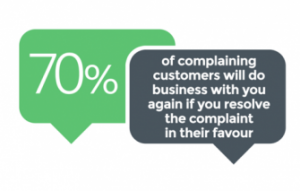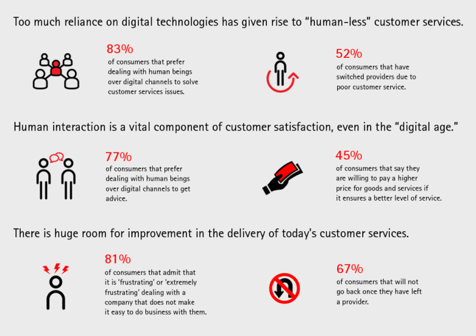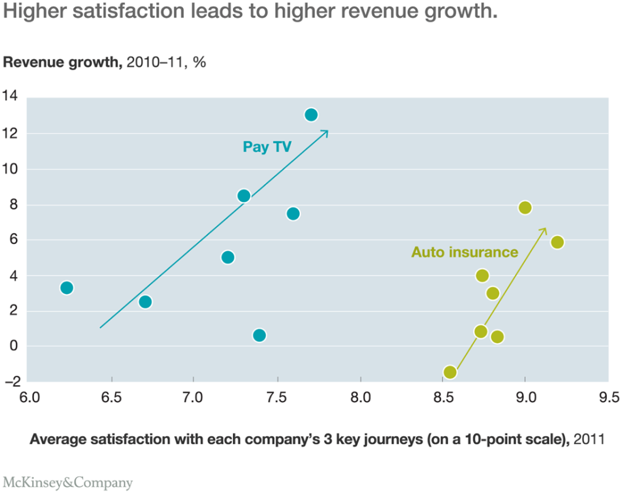NICOLA WATTS on 17 August, 2017 at 10:08
Today’s customers are full of expectations. Expectations that any interaction with a brand will be easy, immediate, consistent and require little or no cognitive effort. Expectations that their experience will reflect their brand relationship. Expectations that they can connect and interact with the brand through their channel of choice whenever they feel the need. Expectations that if a brand claims to stand for something, then it actually does throughout its entire ecosystem. Expectations that if something goes wrong they will be treated in a sensitive, understanding and caring manner.
Today’s customers have never been more vocal when their expectations are not met. The shift in power from brands to customers has been well-documented, and your customers are loving it. Recognising and understanding all three levels of expectation: desired, sufficient and unsatisfactory, is a prerequisite for delivering a superior brand experience and service.
The internet is awash with statistics, such as 95% of people have taken some action as a result of a bad experience, 82% have stopped doing business with the company, and nearly 80% of unhappy customers have told others about their experience. The consequences of not meeting expectations are brutal, as United Airline or Uber can attest.
Intuitively, we all know that providing a superior brand experience is the way to go. But why is this so challenging for so many brands? Surely, the difficult part is getting people to be customers in the first place, right? No, it seems not. The challenge lies in keeping them engaged.
Engagement is about building a relationship with a customer. It’s about treating that customer like a person. Would you treat your family, friends or colleagues the way that some companies treat their customers? The most common mistakes are about being a bad friend, treating people shoddily, or taking them for granted.
- Talking at your customers with a seemingly constant sales pitch, and not to them through holding a conversation.
- Assuming that providing a product or service is sufficient, without explaining how to get the best out of it.
- Not making any effort to engage past the initial sale.
- Bombarding your customers with ill-timed and irrelevant information so they actively choose to tune you out.
- Keeping secrets from your customers, which does not build long term trust.
Are you guilty of any of these? Would you stay friends with someone who treated you like this?

In their eleventh annual Global Consumer Pulse survey, Accenture measured the experiences of 24,489 customers in 33 countries across 11 industries and found that human interaction remains a central constituent of customer satisfaction. Despite our digital age, 83% of US customers prefer to solve customer services issues and 77% prefer to get advice through dealing with human beings. 52% claim to have switched provider in the past year alone due to poor customer service, which they estimate to cost $1.6 trillion. Meanwhile, research by McKinsey found that “emotionally engaged customers are typically three times more likely to recommend a product and to purchase it again.”
How can you improve your customer engagement strategy? Firstly, you need to think more broadly, beyond customer touchpoints or the individual interactions through which a customer connects with your business. Yes, doing your best to ensure that your customer is happy and satisfied every time they interact with you is a very good thing, but it misses the big picture.

Move to thinking about the customer journey in its entirety, rather than a siloed view of your customer’s interaction. You may be getting great customer service satisfaction scores for each of your interactions, but often the whole is not greater than the sum of its parts. Yes, the customer service rep resolved my billing, or my “where is it?” or “why won’t it work” queries in a pleasant, friendly and satisfying manner, but it misses the point completely if I’m not even vaguely happy that I had to track down customer services in the first place. My individual scores will be high, but my overall score is low. This is often a blind spot for an organisation. Research by McKinsey demonstrated that it’s one worth addressing, as “better performance on journeys correlates strongly with faster revenue growth” and that “the companies that perform best on journeys have a more distinct competitive advantage than those that excel at touchpoints”.
Secondly, happy employees equate to happy customers. Happy employees are highly productive, motivated and are passionate to do both their job well and to represent their company positively. Your employees are the ones who drive the customer experience. Empowering your employees is key to turning your customer service aspirations into a reality. Empowered employees are creative and empathetic in their problem solving and highly engaged with their organisation. By not engaging your employees you create a blind spot. Engaged employees deliver consistently better customer service. They are the ones who will make the difference.
We all know that we need to have relevant communication with our customers. But, understanding when and how best to interact is a challenge, together with how on earth you can do this at scale. This is where personalisation engines that provide the ability to trigger action based on a customer’s behaviour and then learn from their interaction come into their own. Research by McKinsey has demonstrated that “personalisation can reduce acquisition costs by as much as 50%, lift revenues by 5 to 15%, and increase marketing spend efficiency by 10 to 30%”.
If you’re thinking that this is nice too, then think again. Research by Salesforce UK in their ‘The State of the Connected Customer’ study found that 45% of customers and 57% of business users claim that by 2020 they will switch brands if a company doesn’t actively anticipate their needs. 73% claim to be influenced by personalised customer care today.
Having the right people, processes and guidelines is the fifth fundamental to get right. Expecting your teams to function within your existing structures and operating processes and with the same historical capabilities is, famously, the definition of insanity. To keep your customers engaged and provide them with a great omnichannel experience that you both benefit from, requires having a two-way consistent conversation with them. To do this your organisation needs to be structured given the capabilities and rewarded for doing so.
In a world where companies increasingly give customers what they want, when they want, where they want and how they want it, providing great customer service is no longer a choice, but a pre-requisite for doing business. Are you focused on optimising your customer service for the future, or just paying lip service? The next few years will tell.






